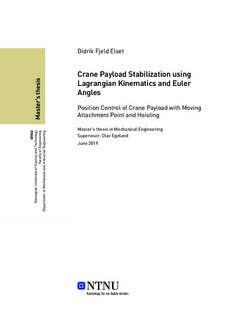| dc.contributor.advisor | Egeland, Olav | |
| dc.contributor.advisor | Tysse, Geir Ole | |
| dc.contributor.author | Elset, Didrik Fjeld | |
| dc.date.accessioned | 2019-10-19T14:00:46Z | |
| dc.date.available | 2019-10-19T14:00:46Z | |
| dc.date.issued | 2019 | |
| dc.identifier.uri | http://hdl.handle.net/11250/2623319 | |
| dc.description.abstract | Denne oppgaven har som formål å teste en kontrollers evne til å stabilisere en nyttlast samtidig som kranen skal bevege seg i en forhåndsinnstilt bane for en rekke ulike situasjoner. Den presenterer bevegelsesligningene for en sfærisk pendel med et bevegelig opphengspunkt ved bruk av Euler-vinkler og Lagrange-mekanikk. Dampingen av svingningene til nyttelasten er gjort ved en tilbakekoblet kontroller og systemets stabilitet er beskrevet ved bruk av Lyapunovs andre metode i samspill med LaSalles teorem for invariante mengder. Dempingen blir så ekspandert til et tilbakekoplet system der både opphengspunktets posisjon og hastighet blir matet tilbake til kontrolleren og brukt sammen med proporsjonalkonstanter for å sikre kranens bevegelse i tillegg til stabilisering av pendelen. Grunnet praktiske utfordringer ved å måle opphengspunktets akselerasjon blir en hastighetssløyfe introdusert.
Videre blir kontrolleren koblet sammen med en såkalt "knuckle boom-kran'' eller jibb-kran med tre frihetsgrader. Kinematikken til kranen er beskrevet gjennom bruk av robotkinematikk, Denavit-Hartenberg-konvensjonen og Jacobian til kranen. Forholdet mellom vinklene i leddene til kranen og de lineære aktuatorene er funnet gjennom bruk av cosinussetningen og andre trigonometriske forhold. En bane opphengspunktet skal følge fra en initiell posisjon til et endepunkt innen en gitt tid. Denne banen er valgt slik at den skal ligne en potensiell løfteoperasjon med et begynnende løft etterfulgt av en bevegelse i det horisontale planet, før den senkes til sin initielle høyde.
Resultatene er presentert gjennom simuleringer gjort i Simulink og Matlab for en rekke parameterverdier og baner. Kontrolleren viser seg å være robust for de fleste scenarioer og danner et lovende grunnlag for integrering i en fysisk kran. | |
| dc.description.abstract | This thesis is testing a controller's ability to stabilize a payload while moving along a preset trajectory for a wide selection of scenarios. It presents the equations of motion for a spherical pendulum with moving attachment point by using Euler angles and Lagrangian kinematics. Damping of the pendulum payload is done by feedback control and the stability analysis is done with Lyapunov's second method and LaSalle's invariance principle. The damping is then expanded into a feedback system consisting of a position loop and a velocity loop to ensure the stability of the pendulum alongside with the desired movement of the attachment point. A second velocity loop is added to prevent the need for measuring the acceleration of the attachment point.
Further, the attachment point is set as the end-effector of a 3 DOF knuckle boom crane. Rotation and transformation matrices, Denavit-Hartenberg convention, and the Jacobian are used to describe the cranes kinematics. The relationship between the joint angles and the linear actuators are found using trigonometry. A trajectory is planned to ensure a smooth path from an initial position to a desired final position within a preset amount of time. The trajectory is chosen to resemble a potential crane routine with hoisting, motion from one position to another in the horizontal plane, and lowering the payload to its initial height.
The results are presented through plots using Simulink and Matlab for a magnitude of parameter values and trajectories. The robustness of the controller is strong for most of the scenarios which make a promising basis for a practical implementation. | |
| dc.language | eng | |
| dc.publisher | NTNU | |
| dc.title | Crane Payload Stabilization using Lagrangian Kinematics and Euler Angles | |
| dc.type | Master thesis | |
